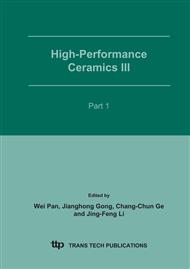p.1449
p.1453
p.1459
p.1463
p.1467
p.1471
p.1475
p.1479
p.1485
The Mechanism of the Formation of MoSi2 by Self-Propagating High-Temperature Synthesis
Abstract:
A combustion front quenching (CFQ) technique was used to investigate the mechanism of selfpropagating high-temperature synthesis (SHS) of MoSi2 from Mo and Si powders. Based on the experimental results, a combination of reactive diffusion and dissolution-precipitation mechanism of the formation of MoSi2 was proposed, and a model corresponding to this mechanism was drawn.
Info:
Periodical:
Pages:
1467-1470
Citation:
Online since:
February 2007
Authors:
Keywords:
Price:
Сopyright:
© 2005 Trans Tech Publications Ltd. All Rights Reserved
Share:
Citation:


